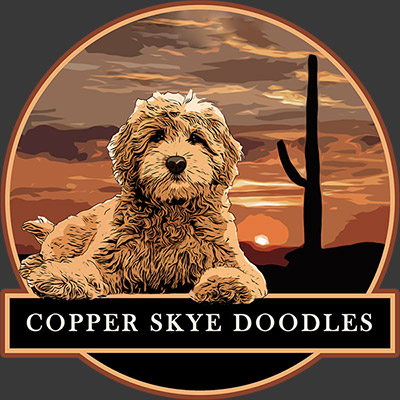Goldendoodle Color
Goldendoodle Color
Goldendoodles are each unique in color and personality. Many people have seen the classic golden or apricot Goldendoodle color, at the park or in pictures. However, these pups come in a wide range of coat shades and variations.
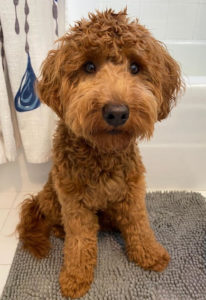
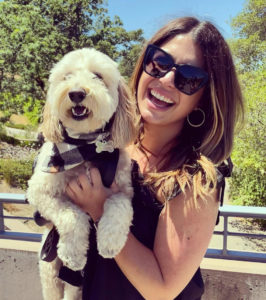
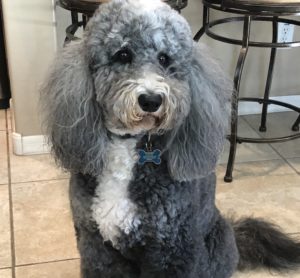
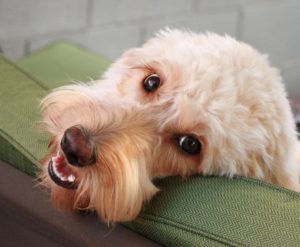
Goldendoodles are a hybrid breed of a Golden Retriever and a Poodle. This combination creates a broad selection of the beautiful Goldendoodle colors we see today. These pups are loved for their intelligence, trainability, playfulness and gentle temperament, in all colors.
Goldendoodles are each unique in color and personality. Many people have seen the classic golden or apricot Goldendoodle color, at the park or in pictures. However, these pups come in a wide range of coat shades and variations.
Goldendoodles are a hybrid breed of a Golden Retriever and a Poodle. This combination creates a broad selection of the beautiful Goldendoodle colors we see today. These pups are loved for their intelligence, trainability, playfulness and gentle temperament, in all colors.

The American Kennel Club identifies three main colors in Golden Retrievers:
- Light golden
- Golden
- Dark golden
Poodles come with coats that are:
- Brown
- Blue
- Red
- Apricot
- Café-au-lait
- Cream
- White
- Black
- Silver
Attractive not only for their low-shedding coats, the wide variety of Goldendoodle colors and choice of coat curl give this pup their adorable look.
The American Kennel Club identifies three main colors in Golden Retrievers:
- Light golden
- Golden
- Dark golden
Poodles come with coats that are:
- Brown
- Blue
- Red
- Apricot
- Café-au-lait
- Cream
- White
- Black
- Silver
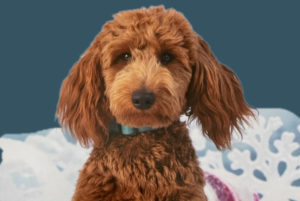
Coat Type and Goldendoodle Color
All of the Goldendoodle colors come with a range of coat length and curl type. Puppies may have curly fur, a shaggy coat, or loose, wavy hair. The length of the coat is controlled by one gene, FGF5, and long hair is a recessive trait typically found in Goldendoodles. Most Goldendooles have a coat length of 2-3 inches, regardless of their color.
Goldendoodle colors cover a range of shades and patterns. One popular coat color is red with tones of apricot. Some Goldendoodle colors look creamy with darker golden undertones. Other Goldendoodles have black or chocolate colored coats.
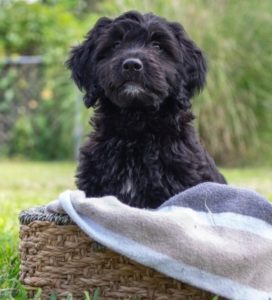
These are typical color choices for Goldendoodle coats:
- Light: Cream, beige, champagne, white
- Medium: Carmel, tan, silver, merle (very rare)
- Dark: Chocolate, brown, black
- Red: Apricot, red
- Parti: two colors or multi-colored
All Goldendoodle colors can result in a low-shed coat. While no dog is truly hypoallergenic, a hybrid dog mixed with a Poodle results in the least shedding. Many people with allergies react more to dander than to fur. At Copper Skye Doodles we breed dogs with the most suitable coats for those with allergies. Goldendoodles of all colors tend to have low dander and minimal shedding.
Coat Type and Goldendoodle Color
All of the Goldendoodle colors come with a range of coat length and curl type. Puppies may have curly fur, a shaggy coat, or loose, wavy hair. The length of the coat is controlled by one gene, FGF5, and long hair is a recessive trait typically found in Goldendoodles. Most Goldendooles have a coat length of 2-3 inches, regardless of their color.
Goldendoodle colors cover a range of shades and patterns. One popular coat color is red with tones of apricot. Some Goldendoodle colors look creamy with darker golden undertones. Other Goldendoodles have black or chocolate colored coats.
These are typical color choices for Goldendoodle coats:
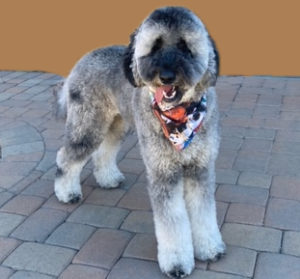
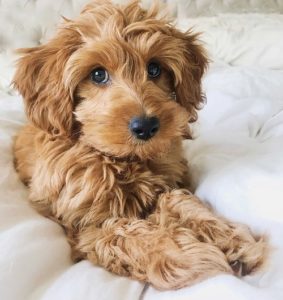
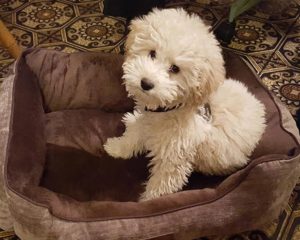
- Light: Cream, beige, champagne, white
- Medium: Carmel, tan, silver, merle (very rare)
- Dark: Chocolate, brown, black
- Red: Apricot, red
- Parti: two colors or multi-colored
All Goldendoolde colors can result in a low-shed coat. While no dog is truly hypoallergenic, a hybrid dog mixed with a Poodle results in the least shedding. Many people with allergies react more to dander than to fur. At Copper Skye Doodles we breed dogs with the most suitable coats for those with allergies. Goldendoodles of all colors tend to have low dander and minimal shedding.

Goldendoodle Colors and Changes
On average, Goldendoodle colors can change as puppies mature. Medium and light Goldendoodle colors tend to see greater changes, while the black and darker brown pups tend to retain their colors. It is possible for darker coats to shift to continuing more gray, blue or silver, if their parents both carried these genes.
It’s common to select a Goldendoodle color that is slightly darker than the expected final color. This leaves room for color variation over time, which usually includes lightening. Dogs of any gender, breed, or age can experience changes to their coat or skin. This may be caused by:
- Nutritional changes
- Sunlight
- Medications, or
- Illness
The color of a dog’s adult fur may differ from their puppy coat. Puppies that keep their same coat through to adulthood are said to “hold” their Goldendoodle color. Puppies seem to hold most of their puppy colors around the muzzle and ears, even if the rest of their coat experiences changes. Puppy coats that fade, dull, or lighten with time are said to “clear”.
The final Goldendoodle color seems to settle between 4 to 6 months, which is around the time puppies lose their puppy coats. In less common cases, the coat changes may start as early as 12 weeks or wait to begin until one year of age.

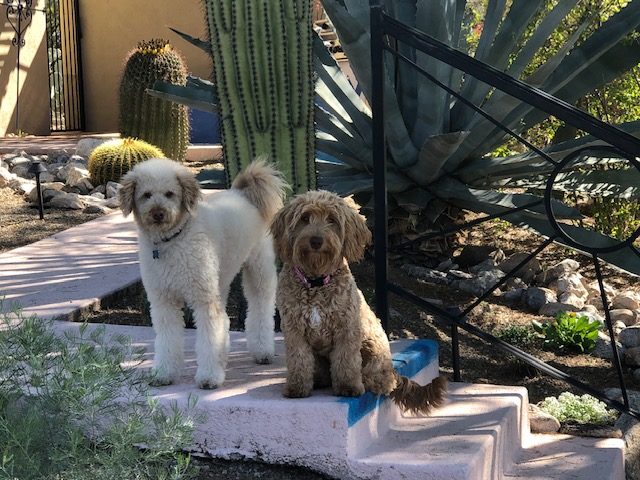
Goldendoodle Colors and Changes
On average, Goldendoodle colors can change as puppies mature. Medium and light Goldendoodle colors tend to see greater changes, while the black and darker brown pups tend to retain their colors. It is possible for darker coats to shift to continuing more gray, blue or silver, if their parents both carried these genes.
It’s common to select a Goldendoodle color that is slightly darker than the expected final color. This leaves room for color variation over time, which usually includes lightening. Dogs of any gender, breed, or age can experience changes to their coat or skin. This may be caused by:
- Nutritional changes
- Sunlight
- Medications, or
- Illness
The color of a dog’s adult fur may differ from their puppy coat. Puppies that keep their same coat through to adulthood are said to “hold” their Goldendoodle color. Puppies seem to hold most of their puppy colors around the muzzle and ears, even if the rest of their coat experiences changes. Puppy coats that fade, dull, or lighten with time are said to “clear”.
The final Goldendoodle color seems to settle between 4 to 6 months, which is around the time puppies lose their puppy coats. In less common cases, the coat changes may start as early as 12 weeks or wait to begin until one year of age.
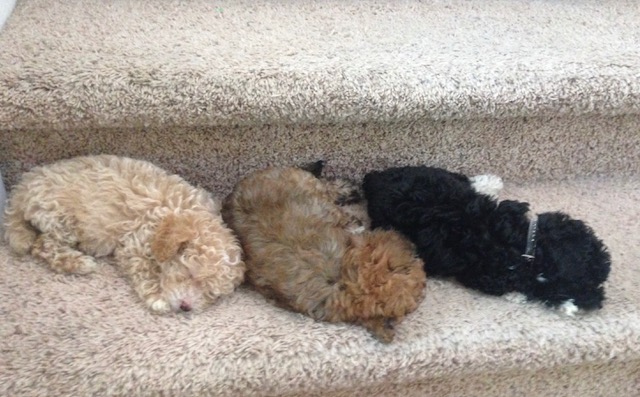

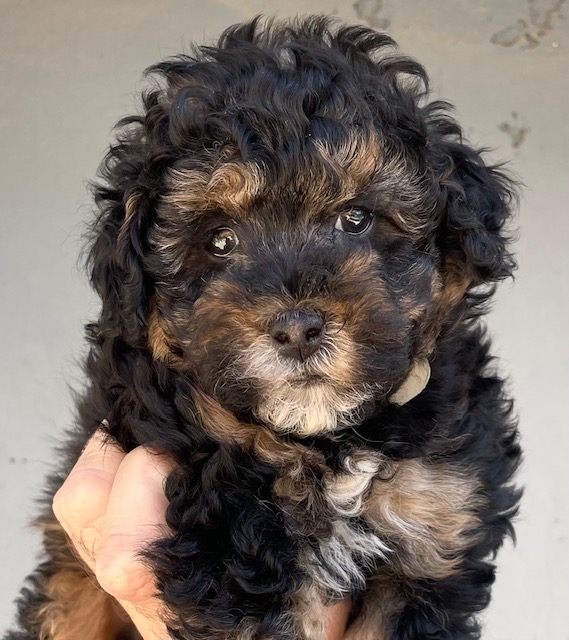

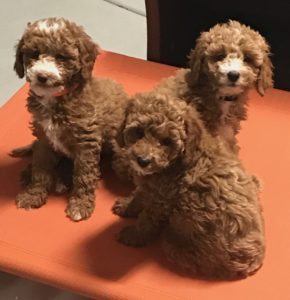
Genetics and Goldendoodle Color
Goldendoodle color is the result of a group of genes frequently referred to as phenotypic genes. These genes control:
- Skin features
- Eye color
- Curl type
- Hair color
- Nose color
Parents pass down a combination of genetic information so that some Goldendoodles look like Golden Retrievers with curly hair. Or, they may look more like golden-colored Poodles with wider facial features and furnishings; the furry, bearded look around the face and eyebrows.
With Goldendoodles, you can selectively breed second and third generation puppies to best emphasize specific traits. The physical characteristics, like Goldendoodle color, become more evident as the genetic variation becomes smaller. This process is generally followed with red Goldendoodles, since red fur color is recessive.
If the parents of your puppy are both Goldendoodles, then their coat color tends to be less likely to change over time. If the parents are a Golden Retriever and a Poodle, the puppy’s coat color is more likely to change in adulthood. This is most often true for the red Goldendoodle color, which can shift to a lighter tan or brown color over time.
One advantage of adopting a Goldendoodle that is not a puppy, is more certainty about the final coat color. The fur on an adult won’t have as much variation in color over time, so it may be better to search for an adult, especially if you have your heart set on a lasting red Goldendoodle color. It’s important to love your Goldendoodle just the way they are, in each stage of life.
Genetics and Goldendoodle Color
Goldendoodle color is the result of a group of genes frequently referred to as phenotypic genes. These genes control:
- Skin features
- Eye color
- Curl type
- Hair color
- Nose color
Parents pass down a combination of genetic information so that some Goldendoodles look like Golden Retrievers with curly hair. Or, they may look more like golden-colored Poodles with wider facial features and furnishings; the furry, bearded look around the face and eyebrows.
With Goldendoodles, you can selectively breed second and third generation puppies to best emphasize specific traits. The physical characteristics, like Goldendoodle color, become more evident as the genetic variation becomes smaller. This process is generally followed with red Goldendoodles, since red fur color is recessive.

If the parents of your puppy are both Goldendoodles, then their coat color tends to be less likely to change over time. If the parents are a Golden Retriever and a Poodle, the puppy’s coat color is more likely to change in adulthood. This is most often true for the red Goldendoodle color, which can shift to a lighter tan or brown color over time.
One advantage of adopting a Goldendoodle that is not a puppy, is more certainty about the final coat color. The fur on an adult won’t have as much variation in color over time, so it may be better to search for an adult, especially if you have your heart set on a lasting red Goldendoodle color. It’s important to love your Goldendoodle just the way they are, in each stage of life.

Care for Goldendoodles of All Colors
Care for Goldendoodles of All Colors




Goldendoodle color is just one factor to consider when you are ready to adopt. All Goldendoodles require regular grooming, so make sure you set aside time and a budget to keep your Goldendoodle’s coat in great shape. I recommend that you plan to have your pup groomed every 6-8 weeks.
Caring for a Goldendoodle is one of the most rewarding experiences. These pups are intelligent and adoring, some of the most loving dogs you’ll ever meet. Their gentle nature and abounding patience makes them great companions and family dogs.
At Copper Skye Doodles, I want to share the joy a Goldendoodle of any color can bring you and your family. If you have specific questions about Goldendoodle color options, I’d be more than happy to speak with you.
I have more than 20 years of experience breeding and loving Goldendoodle puppies and I’d be glad to meet with you in person or over the phone to discuss your hopes and questions. Copper Skye Doodles has an outstanding reputation and has placed hundreds of Goldendoodles into loving homes. I’m happy to take the time to share more with you and learn about which Goldendoodle would fill your heart and home with affection and companionship.
Frequently Asked Questions
Goldendoodles are an intelligent and obedient family companion. They are everybody’s friend and devoted to their family. They are friendly towards children, other dogs and pets, and easy with strangers. They are social dogs, happiest when with people. Goldendoodles are likely to get into mischief and develop behavior problems if they spend most of their lives alone. Their intelligence, eagerness to please, and love of learning make them very easy to train.
Yes. As a hybrid cross, Goldendoodles will inherit fur that looks retriever-like, or poodle-like, but usually something in-between. Unclipped Goldendoodles will have hair about 4-7 inches long, shorter on the face and longer on the body, tail and legs. Without grooming, painful mats can form and your adorable pup will look neglected and unkempt. Expect to thoroughly comb or brush your Goldendoodle regularly (all the way down to the skin). A curly coat will require more brushing than a straight or wavy one. Head to a professional groomer every six to eight weeks or so.
Goldendoodles are energetic, active dogs. Of course, some will be more active than others, but like all dogs, if not given moderate amount of exercise each day, they can easily get into trouble. Plan on your Goldendoodle needing at least two 30-minute periods of exercise per day. This can be accomplished through various means, such as brisk walks, jogging, hiking, swimming, agility work, or just good old-fashioned backyard playtime. Although exercise is needed, they can easily adapt to a life in the city or on a farm or anything in between.
With a name like Goldendoodle, one might think that gold is the only color they come in, but nothing could be further from the truth! Goldendoodles come in a variety of colors, including black, chocolate, red, white, apricot, cream and brown. In addition to the wide variety of colors, Goldendoodles can also be found in a variety of patterns, including merle, brindle, phantom, sable, and parti. With the Poodle heritage and the Golden Retriever heritage both in play here, it’s not surprising that Goldendoodles come in so many colors and patterns. The Poodle and Golden Retriever ancestry both bring apricot, red, and cream to the mix. The same gene controls all three of these colors, but the intensity of the inherited gene is what determines the shade of the color.
Poodles also bring dark brown (chocolate), black, gray, and silver, as well as the patterns, to the mix.
The summary of colors from both Poodle and Golden Retriever is:
- Apricot – From both Poodle and Golden Retriever
- Red – From both Poodle and Golden Retriever
- Cream – From both Poodle and Golden Retriever
- Dark Brown (Chocolate) – Poodle Side
- Black – Poodle Side
- Gray – Poodle Side
- Silver – Poodle Side
- Blue – Poodle Side … Blue, in this case, is like a faded blackish gray
- White – Poodle Side
The summary of patterns inherited from the Poodle is:
- Solid Goldendoodle – This is one solid color.
- Parti Goldendoodle– This combination is white on at least 50% of the body with solid patches of any other color. This unique color may be red parti, chocolate parti, black parti, cream parti, merle parti, apricot parti, or phantom parti. The choices are almost endless.
- Merle Goldendoodle – This beautiful color is a combination of various colors. Because the merle gene can cause deafness or blindness, it’s a rare color.
- Phantom Goldendoodle – Super hard to find phantom Goldendoodles comprise two colors – a base shade (solid chocolate or solid black) and a lighter one. The lighter points are usually to be found above the eyes (eyebrows), on the side of the chest, muzzle, inside the legs and under the tail. Most phantom Goldendoodles are commonly black and tan, but this can vary, e.g., brown and silver. Phantom is a recessive gene, so both parents would need to have it for the puppy to inherit this pattern (so it’s not found in the first generation). However, it’s easy to tell a phantom dog right off as puppies are born with these specific markings. They don’t develop over time like other patterns.
- Sable Goldendoodle – Sable is a gene that gives the dog’s coat the appearance of two tones or colors, with the tips of the hair being black. While these dogs look either brown or black at birth, even at this early time, the root of the hair is much lighter than the tip. Sable Goldendoodles tend to hold onto their dark color around the face and ears. The rest of their coat settles into more of a cream or tan shade, although always with darker tips and lighter roots. This makes for a unique-looking dog!
- Abstract Goldendoodles – Dogs with abstract coats are mostly one single color (be it any of the ones outlined above) with touches of white. These are usually found on their face and around their chest and paws. Such dogs are also referred to as mismarked.
- Tuxedo Goldendoodles – Tuxedo Goldendoodles are another two-color mix. Any of the above colors are combined with white. However, the white is concentrated around the chest and front legs. This gives the pup the appearance of wearing a tuxedo (hence the name). As you can imagine, these dogs are popular because of their distinctive appearance – especially when in black and white. Their markings are apparent from birth. Although, naturally, the white splotches often begin small and get more prominent as the dog matures.
- Brindle Goldendoodles – Brindle, another parti-color pattern, is rarely seen but looks truly striking when coupled with the doodle’s attractive features. This unique pattern of dark and light coat is arranged in such a way as to make the dog look like it has tiger stripes. While the width and color of these stripes vary from dog to dog, in Goldendoodles, it usually takes the form of a black or brown base coat with lighter colored stripes.
- Tri-Colored Goldendoodles – With the increasing amount of multigenerational Goldendoodles, color options are becoming ever more varied. Tri-colored isn’t common to these dogs because this kind of coloring doesn’t occur in either Poodles or Golden Retrievers. However, it is very usual in other types like Bernedoodles (from the Bernese Mountain Dog). Often you will find that Goldendoodles that carry this coloring aren’t Goldendoodles, strictly speaking. They usually have a little of another breed in them – one that does carry the tri-color gene. Golden Mountain Doodles (Golden Retrievers, Bernese Mountain Dogs, and Poodles) are becoming increasingly popular, not least for their cool coloring.
In all honesty, with no coat color or pattern being better than any other in terms of health and behavior, your choice of Goldendoodle should be based on temperament over looks. However, everyone has different preferences about these things. So, once you have ascertained that the puppies you are checking out are all good, you can choose the one that looks best to you. Keep in mind that the Poodle fading and silvering genes make it quite likely that your dood’s coat color will change as they get older. Usually, the intensity is reduced, and black dogs switch to gray or silver while red ones dull down to apricot or cream.
There is no right or wrong answer to this question. Over the years I have discovered that there is very little difference between genders in terms of personality. By today’s standards most dogs are either spayed or neutered which levels the field by eliminating all hormones. I have males and females that are both sweet, smart, friendly, playful, loyal, gentle, etc. I also have some males and females that are highly energetic, mischievous, barkers, toy destroyers, etc. Bottom line, each and every dog/puppy has its own unique personality that’s his/hers alone, and that’s why we love them! However, I always tell prospective buyers that if they have a definite gender in mind then that’s the one they should go with.
Frequently Asked Questions
Goldendoodles are an intelligent and obedient family companion. They are everybody’s friend and devoted to their family. They are friendly towards children, other dogs and pets, and easy with strangers. They are social dogs, happiest when with people. Goldendoodles are likely to get into mischief and develop behavior problems if they spend most of their lives alone. Their intelligence, eagerness to please, and love of learning make them very easy to train.
Yes. As a hybrid cross, Goldendoodles will inherit fur that looks retriever-like, or poodle-like, but usually something in-between. Unclipped Goldendoodles will have hair about 4-7 inches long, shorter on the face and longer on the body, tail and legs. Without grooming, painful mats can form and your adorable pup will look neglected and unkempt. Expect to thoroughly comb or brush your Goldendoodle regularly (all the way down to the skin). A curly coat will require more brushing than a straight or wavy one. Head to a professional groomer every six to eight weeks or so.
Goldendoodles are energetic, active dogs. Of course, some will be more active than others, but like all dogs, if not given moderate amount of exercise each day, they can easily get into trouble. Plan on your Goldendoodle needing at least two 30-minute periods of exercise per day. This can be accomplished through various means, such as brisk walks, jogging, hiking, swimming, agility work, or just good old-fashioned backyard playtime. Although exercise is needed, they can easily adapt to a life in the city or on a farm or anything in between.
With a name like Goldendoodle, one might think that gold is the only color they come in, but nothing could be further from the truth! Goldendoodles come in a variety of colors, including black, chocolate, red, white, apricot, cream and brown. In addition to the wide variety of colors, Goldendoodles can also be found in a variety of patterns, including merle, brindle, phantom, sable, and parti. With the Poodle heritage and the Golden Retriever heritage both in play here, it’s not surprising that Goldendoodles come in so many colors and patterns. The Poodle and Golden Retriever ancestry both bring apricot, red, and cream to the mix. The same gene controls all three of these colors, but the intensity of the inherited gene is what determines the shade of the color.
Poodles also bring dark brown (chocolate), black, gray, and silver, as well as the patterns, to the mix.
The summary of colors from both Poodle and Golden Retriever is:
- Apricot – From both Poodle and Golden Retriever
- Red – From both Poodle and Golden Retriever
- Cream – From both Poodle and Golden Retriever
- Dark Brown (Chocolate) – Poodle Side
- Black – Poodle Side
- Gray – Poodle Side
- Silver – Poodle Side
- Blue – Poodle Side … Blue, in this case, is like a faded blackish gray
- White – Poodle Side
The summary of patterns inherited from the Poodle is:
- Solid Goldendoodle – This is one solid color.
- Parti Goldendoodle– This combination is white on at least 50% of the body with solid patches of any other color. This unique color may be red parti, chocolate parti, black parti, cream parti, merle parti, apricot parti, or phantom parti. The choices are almost endless.
- Merle Goldendoodle – This beautiful color is a combination of various colors. Because the merle gene can cause deafness or blindness, it’s a rare color.
- Phantom Goldendoodle – Super hard to find phantom Goldendoodles comprise two colors – a base shade (solid chocolate or solid black) and a lighter one. The lighter points are usually to be found above the eyes (eyebrows), on the side of the chest, muzzle, inside the legs and under the tail. Most phantom Goldendoodles are commonly black and tan, but this can vary, e.g., brown and silver. Phantom is a recessive gene, so both parents would need to have it for the puppy to inherit this pattern (so it’s not found in the first generation). However, it’s easy to tell a phantom dog right off as puppies are born with these specific markings. They don’t develop over time like other patterns.
- Sable Goldendoodle – Sable is a gene that gives the dog’s coat the appearance of two tones or colors, with the tips of the hair being black. While these dogs look either brown or black at birth, even at this early time, the root of the hair is much lighter than the tip. Sable Goldendoodles tend to hold onto their dark color around the face and ears. The rest of their coat settles into more of a cream or tan shade, although always with darker tips and lighter roots. This makes for a unique-looking dog!
- Abstract Goldendoodles – Dogs with abstract coats are mostly one single color (be it any of the ones outlined above) with touches of white. These are usually found on their face and around their chest and paws. Such dogs are also referred to as mismarked.
- Tuxedo Goldendoodles – Tuxedo Goldendoodles are another two-color mix. Any of the above colors are combined with white. However, the white is concentrated around the chest and front legs. This gives the pup the appearance of wearing a tuxedo (hence the name). As you can imagine, these dogs are popular because of their distinctive appearance – especially when in black and white. Their markings are apparent from birth. Although, naturally, the white splotches often begin small and get more prominent as the dog matures.
- Brindle Goldendoodles – Brindle, another parti-color pattern, is rarely seen but looks truly striking when coupled with the doodle’s attractive features. This unique pattern of dark and light coat is arranged in such a way as to make the dog look like it has tiger stripes. While the width and color of these stripes vary from dog to dog, in Goldendoodles, it usually takes the form of a black or brown base coat with lighter colored stripes.
- Tri-Colored Goldendoodles – With the increasing amount of multigenerational Goldendoodles, color options are becoming ever more varied. Tri-colored isn’t common to these dogs because this kind of coloring doesn’t occur in either Poodles or Golden Retrievers. However, it is very usual in other types like Bernedoodles (from the Bernese Mountain Dog). Often you will find that Goldendoodles that carry this coloring aren’t Goldendoodles, strictly speaking. They usually have a little of another breed in them – one that does carry the tri-color gene. Golden Mountain Doodles (Golden Retrievers, Bernese Mountain Dogs, and Poodles) are becoming increasingly popular, not least for their cool coloring.
In all honesty, with no coat color or pattern being better than any other in terms of health and behavior, your choice of Goldendoodle should be based on temperament over looks. However, everyone has different preferences about these things. So, once you have ascertained that the puppies you are checking out are all good, you can choose the one that looks best to you. Keep in mind that the Poodle fading and silvering genes make it quite likely that your dood’s coat color will change as they get older. Usually, the intensity is reduced, and black dogs switch to gray or silver while red ones dull down to apricot or cream.
There is no right or wrong answer to this question. Over the years I have discovered that there is very little difference between genders in terms of personality. By today’s standards most dogs are either spayed or neutered which levels the field by eliminating all hormones. I have males and females that are both sweet, smart, friendly, playful, loyal, gentle, etc. I also have some males and females that are highly energetic, mischievous, barkers, toy destroyers, etc. Bottom line, each and every dog/puppy has its own unique personality that’s his/hers alone, and that’s why we love them! However, I always tell prospective buyers that if they have a definite gender in mind then that’s the one they should go with.

